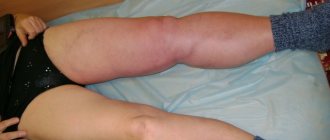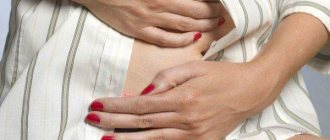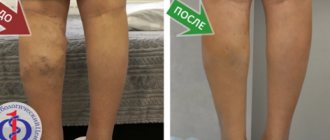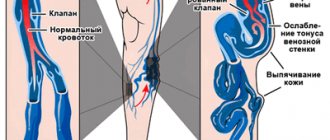A separate area on my leg hurts. The skin is thick, hot, marble-white. Suddenly there was a high fever, weakness and severe swelling of the leg. Accompanied by cold-like symptoms, but antibiotics do not help...
Phlebitis is an inflammation of the walls of a vessel, which leads to the gradual destruction of the vessel completely. The danger of the disease lies in complications due to the patient’s lack of desire to seek medical help.
The appearance of blood clots (thrombophlebitis), blockage of veins, thrombosis, abscess - these are the consequences of lack of treatment. To avoid them, listen carefully to your own body. He will definitely indicate the first signs of the disease. A qualified specialist, a phlebologist, will help determine the disease.
It is important to see a doctor at the first symptoms. Timely help will help you get rid of phlebitis, possible complications and causes of the disease almost without a trace. Let's figure out how to recognize and treat phlebitis in time.
Doctor, what's wrong with me?
If your legs (or one leg) are swollen and red, we recommend consulting a doctor.
Especially if swelling occurs regularly. According to experts, swelling is not the norm. Even if you stand on your feet all day and are tired, the presence of recurring swelling still indicates certain problems. Do not self-medicate, especially if you notice redness and pain on your leg. This condition may be the result of an injury that you did not pay attention to at first. Or it may indicate the presence of a serious illness (including thrombophlebitis), for which it is necessary to receive professional medical help as quickly as possible. There may be several reasons for swelling and redness of the leg.
Varicose veins - what is it and how to live with it?
As an advertisement
Varicose veins are a very common phenomenon. According to statistics, in Russia various forms of varicose veins occur in 30 million people. Women experience the disease more often than men1.
With varicose veins, the walls of blood vessels lose their elasticity and become thinner. The veins themselves become tortuous, and nodular protrusions appear under the skin. Due to the deformation of blood vessels, the venous outflow of blood is disrupted2.
Symptoms of varicose veins of the legs
With varicose veins, symptoms vary depending on the stage of the disease3.
I. At the initial stage
Varicose veins may not manifest themselves in any way, so diagnosing the disease is quite difficult. However, without treatment, over time, a feeling of heaviness and fullness in the legs, swelling, and calf cramps arise. Spider veins are added to the signs of varicose veins in women, but without accompanying symptoms it can simply be a cosmetic defect.
II. At the second stage
swelling and fatigue no longer go away after a night's rest. The skin on the legs may become less sensitive, dryness and flaking appear, sometimes reddish or dark spots, itching.
III. At the third stage
changes in veins and skin are visible to the naked eye. Venous vessels become swollen. There is constant pain in the legs, the skin in some places acquires a bluish tint. Patients are increasingly experiencing cramps in their calves. Systemic problems begin due to impaired blood flow, for example, headaches.
IV. At the last – fourth stage
manifestations of varicose veins progress. Trophic ulcers appear in places of inflammation on the skin. The risk of blood clots and thrombophlebitis – inflammation of the veins – increases.
Also, with varicose veins, the local temperature may increase. In the later stages, even minor bruises and wounds on the lower leg lead to minor hemorrhages4.
Why do varicose veins appear?
There are primary and secondary varicose veins5:
• primary varicose veins are caused by congenital, often hereditary, factors: insufficiency of the venous wall or valves that direct blood flow from the lower extremities to the heart;
• the development of the secondary form of varicose veins is influenced by a person’s lifestyle and occupation.
Representatives of professions with a static load are at greatest risk, when they have to sit or stand motionless for a long time, or lift heavy objects. These are, for example, surgeons, teachers, waiters. The disease is more likely to develop in obese people6.
Some causes of varicose veins apply only to women7:
• dyshormonal conditions, including those caused by taking hormonal contraception, replacement therapy;
• Pregnancy also increases the risk of the disease, but in most women, after childbirth, the veins return to a healthy state.
Is it possible to cure varicose veins?
Many changes in the veins are irreversible, so at the first signs of varicose veins you should consult a phlebologist. To make a diagnosis, a specialist will conduct an examination, perform hardware diagnostics and prescribe tests.
If the disease is severe, the main treatment will be surgical. Minimally invasive methods such as sclerotherapy or laser coagulation are possible8.
In the early stages of varicose veins, conservative treatment is sufficient, which may include:
• venotonics, improving blood flow and strengthening the walls of blood vessels. For example, Venolife duo® is a complex drug that helps strengthen capillaries and increase venous tone9;
• anticoagulants, which thin the blood and prevent blood clots from forming. Venolife® gel prevents blood clots, helps cope with swelling and pain in the legs, accelerates the healing of trophic ulcers10;
• anti-inflammatory drugs;
• compression underwear.
To prevent varicose veins, it is recommended to normalize weight, eat right and exercise. If you work sedentary or standing, you can wear compression socks or stockings.
THERE ARE CONTRAINDICATIONS. BEFORE USE, CONSULT A PROFESSIONAL.
Products by topic: [product](Venolife gel), [product](Venolife Duo).
1. Litynsky A.V., Polyakov P.I., Gorelik S.G. Modern problems of varicose veins of the lower extremities (epidemiology, diagnosis, treatment) and its features in people of older age groups // Scientific bulletins of Belgorod State University. Series: Medicine. Pharmacy. 2012. No. 5 (part 2). pp. 276-280.
2. Daudyaris J.P. Diseases of the veins and lymphatic system. // M.: “Medicine”, 1984. P. 59-97.
3. Ibid.
4. Petukhov V.I. The nature of functional disorders in patients with varicose veins and the possibilities of sclerotherapy // Bulletin of Vitebsk State Medical University. 2005. No. 2, volume 4. pp. 22-27.
5. Evdokimov A.G., Topolyansky V.D. Diseases of the arteries and veins: A reference guide for the practitioner. // 2nd ed. M.: Soviet sport, 2001. P. 182.
6. Clinical recommendations. Varicose veins of the lower extremities without chronic venous insufficiency // Ministry of Health of the Russian Federation.
7. Ibid.
8. Ibid.
9. Venolife Duo, instructions. // https://www.venolife.ru/instructionDuo.pdf
10. Venolife Gel, instructions. // https://www.venolife.ru/instructionGel.pdf
Joint disease
Some joint diseases are accompanied by swelling and redness of the skin in the area of the affected joint. If it is a chronic disease, then patients know about it and pay attention. But there are also injuries that manifest themselves with these symptoms.
Joint injuries are always accompanied by pain. If it is not strong, if the joint is not swollen and its contours are not changed, you can bandage your leg with an elastic bandage and consult a doctor. If the pain is severe and does not go away with rest, if the joint is deformed, the leg is very red and swollen, this indicates that you should seek medical help immediately.
Do the veins in your legs hurt? How to get rid of pain from varicose veins
With each day approaching warm spring and summer, some groups of people are more often thinking about the form of clothing that they will have to wear so as not to cause aesthetic discomfort to themselves and others.
It's all about varicose veins in the legs. If you are familiar with the feeling of “tired legs”, unusual bursting pain in the limbs in the evening after a hard day at work, swelling that does not allow you to fit into the right shoe size, then chronic venous insufficiency is already on the threshold. The most important thing to do is to prevent the disease from further developing into varicose veins, when blue spider veins and swollen silhouettes of veins appear on the legs.
Allergy
Many allergic reactions, such as those caused by insect bites, involve redness and swelling of the skin. In case of allergies, the patient usually complains of redness and itching on the legs. With the onset of the warm season, you need to especially carefully monitor your condition: insects may be hiding in the grass. In case of a severe reaction, unpleasant symptoms can be relieved by taking an antihistamine. If you leave allergies unattended, getting rid of unpleasant symptoms will take a very long time.
Causes of phlebitis
Slowing blood flow is the most common cause of phlebitis, especially when the venous wall is weakened and prone to varicose veins.
Phlebitis can also develop if a vein is compressed for a long time by tight clothing or, for example, squeezed by the edge of a chair. Another common cause is venous catheters that are left in a vein for several days to give infusions or medications. Phlebitis can also be caused by mechanical damage to the venous wall or the penetration of bacteria after operations and during prolonged bed rest. Another common cause of vein inflammation is damage to the vessel wall. This damage may be caused by:
- Infusions, e.g. during or after surgery,
- blood sampling,
- venous access (catheter) or
- a bite of an insect
The entry of bacteria can cause the development of inflammation of infectious phlebitis. Blood composition also plays an important role in the development of phlebitis. Blood clotting may increase due to illness or lack of fluid in the body. This can lead to the development of blood clots.
"Cardiac" edema
With diseases of the cardiovascular system, in particular with heart failure, swelling also occurs, which in some cases may be accompanied by redness of the legs. In this case, swelling increases if it is hot outside, if a person spends a lot of time on his feet. But at rest the swelling subsides. The leg in the area of swelling is soft to the touch.
Interestingly, cardiac edema can go away on its own if the heart function improves at some point or the patient reduces the level of activity. However, their appearance indicates that you need to contact a cardiologist.
Examination of patients with pain in the veins of the leg
When examining patients who have leg pain in the vein area, phlebologists pay attention to the location of the pain and the color of the skin over the vein. If a vein appears on the leg and it hurts, an ultrasound scan is performed. Doctors use 1, 2 or 3 research modes. The main one is B-mode. Additionally, color coding of blood flow or pulsed wave Doppler, as well as a combination of both, is used. The method allows you to simultaneously examine the vein in the leg that hurts, determine the direction of blood flow and its parameters. Patients who have pain and stretching of the veins in their legs must undergo an examination of the superficial and deep veins of both lower extremities.
At the Yusupov Hospital, doctors for ultrasound scanning use devices that are equipped with linear sensors with a frequency of 5 MHz and more from the world's leading manufacturers. To scan deep veins, especially in obese patients, convex sensors with a lower radiation frequency (from 3.5 to 5.0 MHz) are used.
Doppler ultrasound allows you to obtain sound information, which doctors use to judge the presence or absence of blood flow through the main veins. By changing the sound signals during functional tests, blood reflux (reverse discharge) is detected. During X-ray contrast venography, the phlebologist examines the deep and superficial veins. He receives comprehensive information about the morphological changes of the venous system. This research method is used when planning surgery in patients with blocked or underdeveloped veins. Phlebologists at the Yusupov Hospital use the technique of transfemoral ascending phlebography.
Radionuclide phlebography allows you to obtain data on the nature and direction of blood flow through deep, superficial and perforating veins under conditions that are as close as possible to physiological ones. The study is carried out with the patient standing while simulating walking. Radiophlebography allows for an integrative assessment of blood flow throughout the entire system simultaneously.
Intravascular ultrasound examination is carried out to determine the shape and extent of the narrowed segment of the vein when its patency is impaired after thrombosis or compression of the venous vessel from the outside. Infrared thermography, computer thermal imaging, radiothermometry are used as an additional method of studying patients whose cause of pain in the veins of the legs is chronic venous insufficiency. Using this method, the dynamics of the inflammatory process in tissues is monitored, as well as the effectiveness of therapeutic measures is assessed.
Varicose veins
Varicose veins are one of the most common causes of edema. Due to the weakening of the tone of the venous walls, the blood in the vessels stagnates, and the fluid pressure in the vessels increases. The body tries to regulate this situation on its own, and as a result, some of the fluid leaks into the tissue surrounding the vessel.
Varicose swelling usually worsens in the evening. To relieve the condition, you need to lie down and elevate your legs. You can also wear compression stockings (if you have one) or do some exercises to get your blood flowing. It is also useful to make contrast baths.
But if you notice a combination of redness of the skin on your legs and swelling, we recommend that you consult a doctor. This may be a manifestation of thrombophlebitis - a dangerous condition when the lumen of a vein is closed by a thrombus, a blood clot. As a result, blood flow through such a vessel stops.
Thrombophlebitis requires mandatory treatment from a specialist. If blood clots form in the lumens of the vein, it means that a floating thrombus may form in one of the vessels. It is able to move through the bloodstream, and can ultimately clog the pulmonary vessels.
So, if your legs are very red and swollen, or if the redness on your leg is accompanied by pain, rush to the doctor. After all, this may be the result of a minor injury, or it may indicate a somatic disease or the formation of blood clots. Only a specialist will determine the true cause of your condition and help normalize the situation. Treat yourself and your health carefully and feel light and comfortable!
Phlebitis - symptoms and treatment
The outer cellular layer of the vein is called adventitia . It is an elastic membrane, contains a large number of collagen fibers that form the framework of the vein, and a certain number of muscle fibers located along its bed. The middle - muscular - layer of the vein contains the largest number of smooth muscle fibers. They are arranged spirally around the lumen of the vessel and are enclosed in a network of convoluted collagen fibers. When the vein is strongly stretched, the collagen fibers straighten and its lumen increases. The inner cell layer is called the intima . It consists of endothelial cells, as well as smooth muscle and collagen fibers.
The inflammatory process with phlebitis can begin in both the outer and inner layers of the vein. The mechanism of development of pathology may be associated with one of the reasons:
- external trauma;
- internal direct endothelial injury;
- inflammation of the vein wall;
- primary blood clotting disorder.
External trauma may result from direct external force due to blunt trauma or external dressings [8]. The vein contracts, the width of its lumen is impaired. As a result, blood flow slows down, which leads to the development of thrombosis and phlebothrombosis, and local long-term exposure provokes the appearance of local phlebitis. A decrease in blood flow rate and venous stagnation is also observed with visible varicose veins and local external damage - trophic ulcers.
Damage to the inner wall involves direct disruption of the adventitia cells. It activates the same inflammatory response as external trauma, with similar consequences. The injury is often associated with routine intravenous procedures, including phlebotomy (vein cutting) and intravenous infusions through a catheter (action of solutions, damage to veins from needles).
The time the catheter is placed in the vein is related to the rate of inflammation. The longer it stays there, the higher the risk and rate of development of phlebitis, as well as the likelihood of a bacterial infection, during which purulent superficial venous thrombosis may occur.
In addition, infusion of hypertonic solutions can directly damage the endothelium. This usually applies to diazepam and pentobarbital. They can cause chemical inflammation that disrupts the normal functioning of the vein and leads to the formation of blood clots around the tip of the catheter, secondary infection and sepsis. Also, infusion of solutions into areas with slower venous return is more likely to cause superficial vein thrombosis.
What are the stages of varicose veins?
The insidiousness of dilated veins in the chronic, invisible course of the disease. If the problem is not detected in a timely manner, at a stage when it has already become visible, serious complications can occur in the future. Chronic failure has three main stages:
- The presence of a permanent feeling of “tired” legs, the appearance of swelling in the evenings, painful sensations of a dull nature, as well as the formation of spider veins.
- The appearance of trophic pathologies in the legs is noted due to changes in biochemical processes in the tissues of the veins. The swelling becomes even more pronounced and is accompanied by itching, sometimes cramps, as well as aching pain radiating to the inner bends of the knees. The walls of the venous vessels become convex and visible to the naked eye. Often it is at this stage that the patient turns to the clinic for the help of a phlebologist, focusing primarily on the increasingly unaesthetic appearance of the lower extremities.
- The patient is bothered by severe swelling and pain in the legs, thrombophlebitis and blood supply disorders are diagnosed, and trophic ulcers occur.
Vascular surgeons warn that fatigue in the legs, dull pain in the legs in the evenings are signs of impaired blood supply in the veins, so it is necessary to consult a doctor in advance so as not to end up on the operating table.









